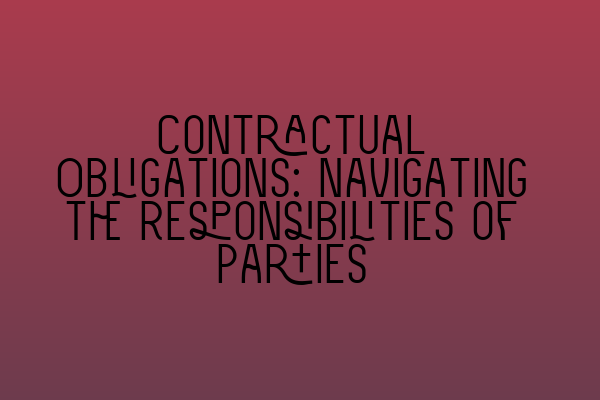Contractual Obligations: Navigating the Responsibilities of Parties
In the realm of business transactions, contracts provide the essential framework for ensuring the smooth operation of agreements between parties. Whether you are a seasoned entrepreneur or a budding start-up, understanding contractual obligations is crucial for successful business dealings. In this blog post, we will explore the intricacies of contractual obligations and provide guidance on how to navigate these responsibilities effectively.
Key Concepts: Contracts, Obligations, Parties
Before delving into the depths of contractual obligations, let us first define some key concepts that form the foundation of this subject matter.
Contracts: A contract is a legally binding agreement between two or more parties. It establishes the rights and obligations of each party involved and serves as a framework for their relationship.
Obligations: Contractual obligations refer to the specific duties and responsibilities that parties agree to perform or abide by under the terms of the contract. These obligations may be explicit or implied and can vary depending on the nature of the agreement.
Parties: In a contract, parties are the individuals, organizations, or entities involved in the agreement. Each party has certain rights and obligations, which are set out in the contract.
Understanding Contractual Obligations
Contractual obligations are the building blocks of any agreement, and a detailed understanding is crucial to avoid disputes or misunderstandings down the line. Let’s dive into the different types of obligations that parties may have:
1. Performance Obligations: Performance obligations are the core responsibilities that each party must fulfill under the contract. These obligations outline the specific tasks, services, or deliverables that the parties are expected to provide. For example, if Party A is a software developer and Party B is a client, the performance obligation may include the development and delivery of a customized software solution.
2. Payment Obligations: Payment obligations involve the financial aspect of the contract. Parties are required to fulfill their payment obligations promptly and as specified in the contract. It is essential to outline the terms and conditions related to payment, such as due dates, payment methods, and late payment penalties, to avoid any potential conflicts.
3. Confidentiality Obligations: In certain contracts, parties may have a confidentiality obligation, especially when sensitive information or trade secrets are shared. This obligation ensures that the parties involved maintain confidentiality and do not disclose proprietary information to third parties.
4. Compliance Obligations: Compliance obligations refer to the requirement of parties to meet specific legal or regulatory requirements. These obligations may include adherence to industry standards, health and safety regulations, or data protection laws.
5. Termination Obligations: Termination obligations outline the conditions and procedures for ending the contract. Parties must understand their obligations when terminating the agreement to prevent any breach of the contract or potential legal complications.
Navigating Contractual Obligations: Best Practices
To navigate contractual obligations successfully, it is essential to adopt certain best practices to protect your interests and ensure a smooth contractual relationship. Here are some strategies to consider:
1. Drafting Clear and Comprehensive Contracts: Clarity is paramount when it comes to contract drafting. Clearly outline all obligations, rights, and responsibilities of each party in the contract to minimize ambiguity and potential disputes. Seek legal advice when necessary to ensure all essential elements are included.
2. Thoroughly Review Contracts Before Signing: Before signing any contract, carefully review and understand all obligations set forth in the agreement. Take note of any potential risks, obligations, or clauses that may impact your business interests. Seek legal advice if you have any doubts or concerns.
3. Communicate Openly and Regularly: Establish open lines of communication with the other party throughout the duration of the contract. Discuss any changes, concerns, or potential issues promptly to avoid misunderstandings and mitigate risks. A proactive approach to communication can help resolve any potential conflicts before they escalate.
4. Keep Accurate Records: Maintain accurate records of all communications, changes, and performance to substantiate compliance with contractual obligations. These records can be invaluable in the event of a dispute or claim.
5. Seek Legal Guidance: When facing complex contractual obligations or disputes, do not hesitate to seek professional legal assistance. An experienced contract law solicitor can provide guidance, ensure compliance, and help resolve any potential conflicts.
Conclusion
Navigating the responsibilities and obligations of parties in contractual agreements is a critical aspect of business success. By comprehending the different types of obligations and following best practices, both contracting parties can establish a strong foundation for a mutually beneficial relationship. Remember, understanding and adhering to contractual obligations not only protects your business interests but also fosters trust and collaboration with your partners.
